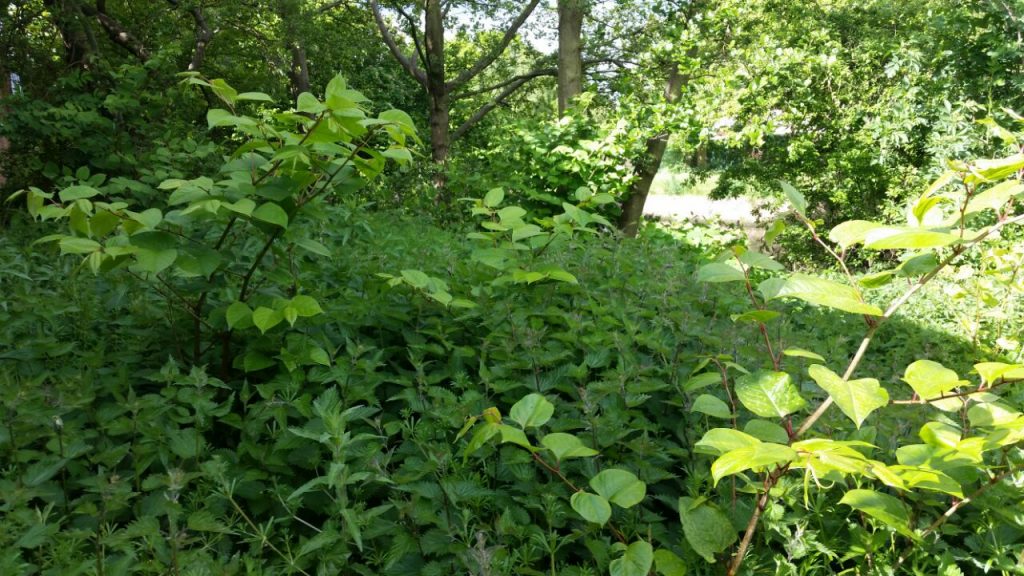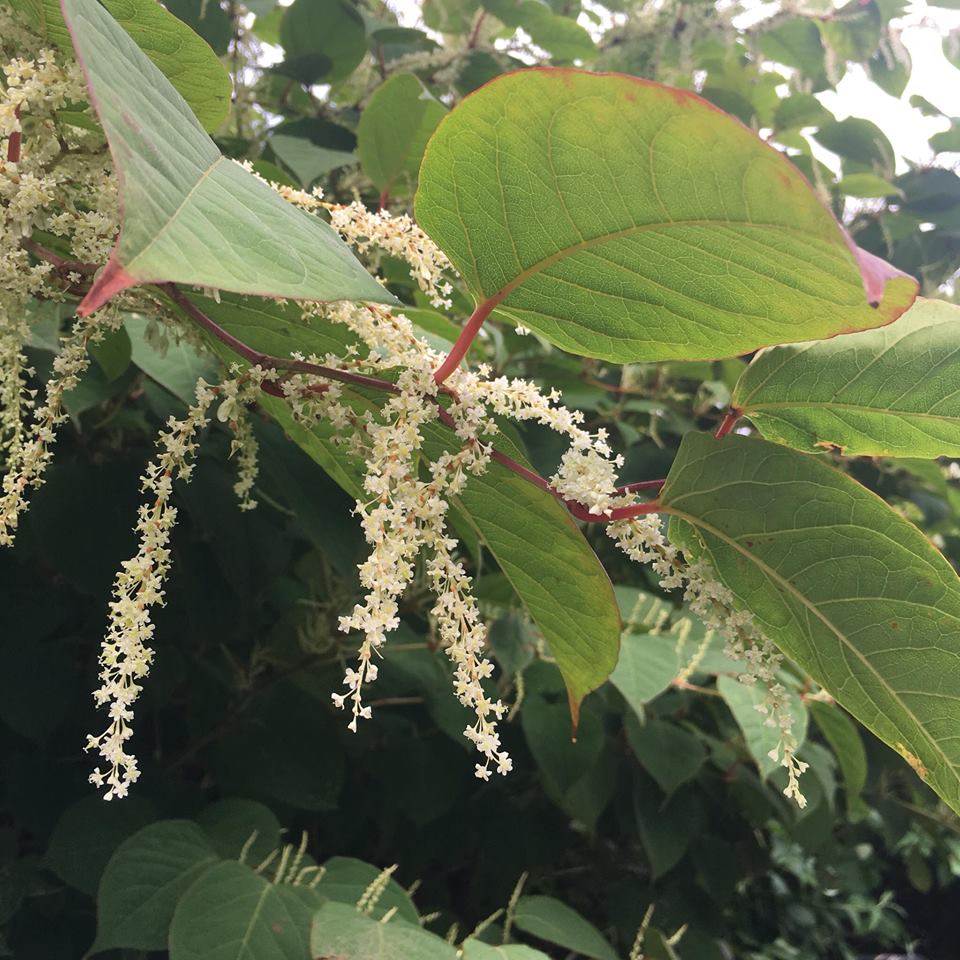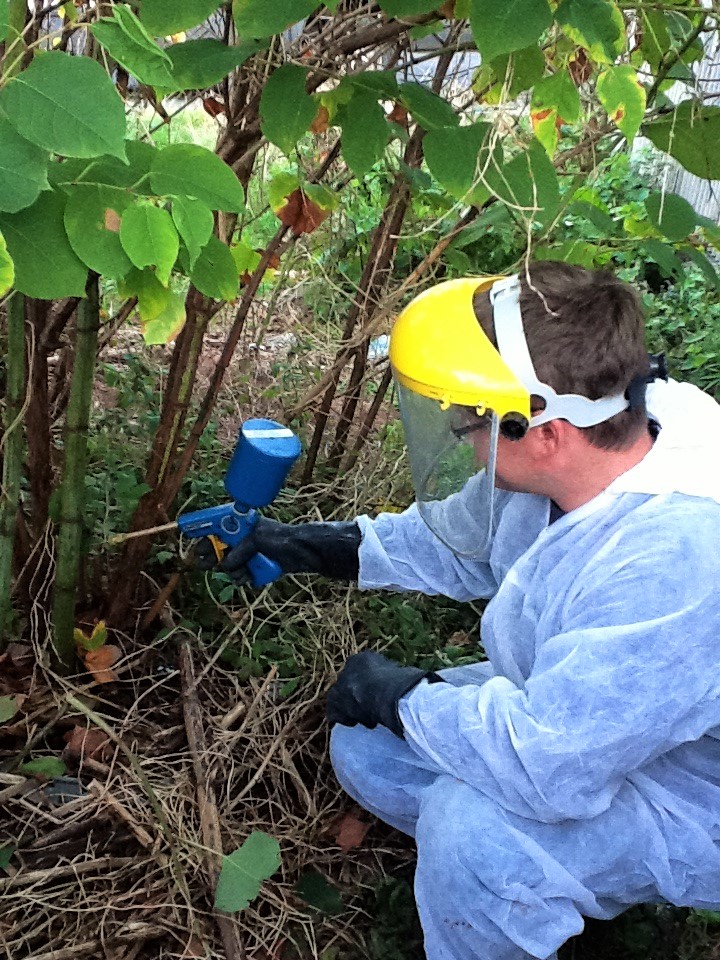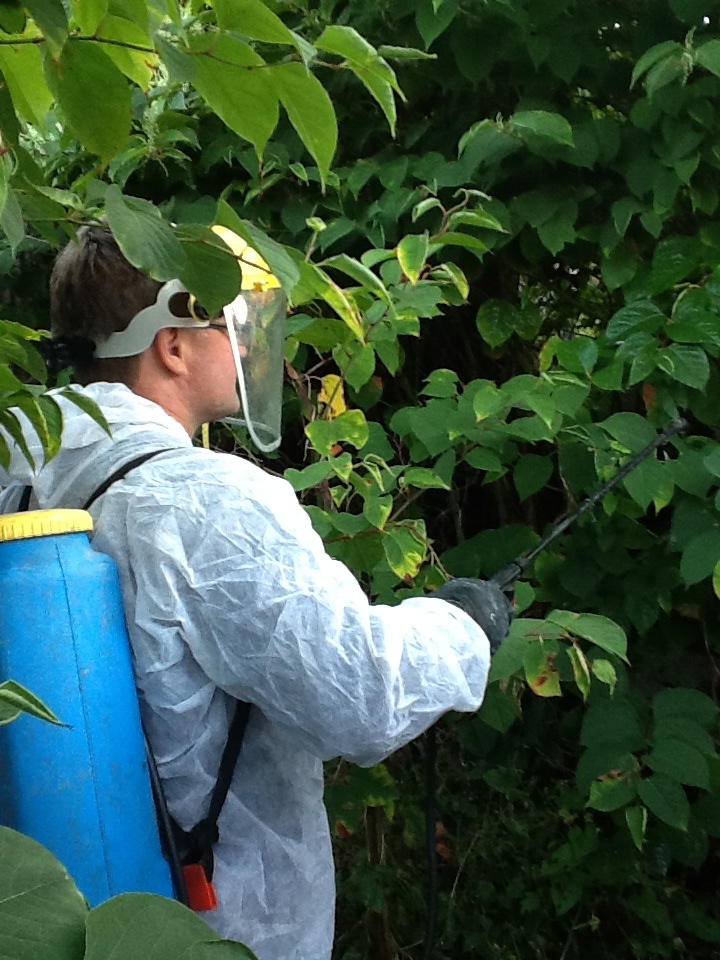Japanese Knotweed
 Japanese Knotweed (Reynoutria japonica) is a particularly invasive and difficult to control weed. In fact, it is listed in the top 100 most invasive plants in the world. Managing Japanese Knotweed requires specialist knowledge and the correct qualification to spray the necessary herbicides to destroy it. Here at Blue Iris Landscapes Ltd, we have a wealth of experience in dealing with Japanese Knotweed successfully in many sites over Staffordshire and Cheshire. We have a specialised website dedicated to our Japanese Knotweed Eradication Services, so for further information, please click here.
Japanese Knotweed (Reynoutria japonica) is a particularly invasive and difficult to control weed. In fact, it is listed in the top 100 most invasive plants in the world. Managing Japanese Knotweed requires specialist knowledge and the correct qualification to spray the necessary herbicides to destroy it. Here at Blue Iris Landscapes Ltd, we have a wealth of experience in dealing with Japanese Knotweed successfully in many sites over Staffordshire and Cheshire. We have a specialised website dedicated to our Japanese Knotweed Eradication Services, so for further information, please click here.
Why not ignore the problem?
Why not ignore the Japanese Knotweed growing at the bottom of your garden, on a corner of your Brownfield site or next to your factory/office complex? If ignored, it will cost a lot of time and money dealing with the problem. The five main reasons not to ignore Japanese Knotweed are:
- If not dealt with, it grows and takes over, costing even more to deal with.
- Potential prosecution and compensation claims against you!
- It will come-up through tarmac, concrete and damage drains and buildings; breaking their concrete foundations.
- It damages the environment.
- You will not be able to get a mortgage or re-mortgage a property with Japanese Knotweed growing near it.
There are two ways to manage Japanese Knotweed. Firstly through spraying herbicides and then secondly, physically removing it.
Please see lower down the page for more information regarding these methods and derivatives of them.
Legislation & Japanese Knotweed
All you need to know as the client is that we fully comply with all legal legislation, all Health and Safety precautions are taken as per HSE directives and all qualifications are up to date when using herbicides.
The Control of Pesticides 1986, this shows all reasonable care has to be taken when using chemicals, to protect humans, wildlife and other flora. This is done through closely following COSHH Guidelines. Risk Assessments are carried out for each site and then we follow Method Statements that are produced based on the Risk Assessment.
Environmental Protection Act 1990, this act refers in particular to “controlled waste” which, by definition, Japanese Knotweed is, including the soil in which the Japanese Knotweed has been growing. It is an offence to transport or dispose of Japanese Knotweed without a license. We have the necessary licenses to transport if required.
Wildlife and Countryside Act 1981, anyone who plants or causes to grow Japanese Knotweed will face a fine of £5,000 or/and 6 months imprisonment. In effect, by not treating the Japanese Knotweed, you are “causing” it to grow, therefore are open to prosecution.
Identifying Japanese Knotweed
Japanese Knotweed- Fallopia japonica is a rhizomatous perennial, which means it begins to grow in March/April time. It can grow to 3m (12ft) in one season and then it dies back during the winter. This process leaves tall stems that can take over two years to rot down.

The invasive root system, combined with strong growth can damage foundations, buildings, roads, paving, retaining walls and architectural sites. It can grow up to 40mm per day that is 1.2m per month and it spreads rapidly. New growth in the spring is red/purple. It has hollow stems with a distinctive purple speckle; stems can reach a maximum height of 3 to 4 metres in a growing season. The leaves are broad and heart-shaped, and they can reach 120mm long. Fallopia japonica also has small creamy white flowers from August to October. The rhizome root system is very knotty and woody in appearance but if snapped it appears orange. The depth of the roots can be up to 2m. However, the spread is more as it can be as much as 7 metres in any direction from the parent plant. Regeneration can occur from a piece of the plant as small as 0.7g of root material or a 10mm length of the root. The rhizome root material can remain dormant for up to 20 years.
I have Japanese Knotweed, what can I do?
Ensure that the Japanese Knotweed has not moved elsewhere infecting the whole site!
To achieve this:
- Put into place a Japanese Knotweed Management plan (KMP).
- Everyone should be able to identify the Japanese Knotweed.
- Identify all areas where the Japanese Knotweed is growing.
- Ideally, the area should be fenced off.
- As the roots can spread up to 7m from the plant, it may be necessary to excavate inspection pits to see where they have extended to, then include this area in the fenced area.
- Signs should be displayed to warn people of the infection.
- Vehicles should not be permitted to pass through the area.
- If vehicles have to pass through the area, however, then the tyres should be washed off before travelling to other areas.
- If the contaminated soil is moved, the vehicles used in the transporting of it should be power-washed after use.
- Any debris from the cleaned vehicles should be treated as contaminated waste.
- You have one person responsible for a “clerk of works”.
How we deal with Japanese Knotweed
When we survey your site for Japanese Knotweed, we will provide you with both a Site Assessment report and a Japanese Knotweed Management Plan.
Site assessment reports will include:
- Site plan to scale (OS grid reference)
- The whole site walked over including, where possible, looking over boundary fences and walls.
- The general condition of the plants.
- An assessment of all apparent site features that may affect recommended control action. e.g. proximity to other vegetation, underground services, built structures and bodies of water.
- A Risk Assessment – this will include the intended use of the site, details of the invasive species that have been identified on site and on adjacent properties, the potential for fly-tipping and the potential to breach legislation that relates to invasive species, their control and their disposal.
- An estimate of how long the outbreak has been established
- Where possible, a site history including previous control methods will be included along with an assumption of how the site became infested.
- Whether any current ground maintenance may hinder the proposed treatment or increase the risk of further contamination.
 It is vital to have a Japanese Knotweed Management Plan (KMP). This will state the most effective way of dealing with the Japanese Knotweed. This includes a number of facets to ensure the eradication of the Japanese Knotweed with an overall plan which includes the whole site.
It is vital to have a Japanese Knotweed Management Plan (KMP). This will state the most effective way of dealing with the Japanese Knotweed. This includes a number of facets to ensure the eradication of the Japanese Knotweed with an overall plan which includes the whole site.
The Management plan includes:
- The objectives of the management
- An evaluation of control options (if applicable and will be influenced by the proposed use of the land)
- A detailed description of the control actions to be taken
- An assessment of the risks associated with the control actions
- A description of how the success of the control action will be evaluated
- Advice on how to prevent Japanese Knotweed arriving on site
- A treatment schedule
- A full breakdown of costs associated with the control action
There are usually four methods of dealing with Japanese Knotweed:
- Herbicide treatment
- Burying of the Japanese Knotweed in a temporary Bung or permanently
- Excavation & removal from site
- Burning
Herbicide treatment of Japanese Knotweed
This is our preferred method of dealing with the plant. We have all the necessary, National Proficiency Tests and Council certification. Typical weed killers we use are Glyphosate, during the active growing period. Triclopyr and 2, 4-D Amine can also be used through the growing season. Spraying should not occur when plants are in flower as weed-killer is translocated through the entire plant and can kill bees and other pollinators. As the rhizome can remain dormant for up to 20 years we actively check to see if the root is also dead before disturbing the soil, this will then avoid contamination of other areas.
Injection
We can also perform injection treatments, this is ideal if the Japanese Knotweed is near a watercourse or if it is growing adjacent to specimen plants that you don’t want to be affected by spraying a systemic translocating herbicide.
Table of Suitable Herbicides Depending on Condition:
| Herbicide | Affects Grasses? | Time of Application | Approved for use near water? | Persistency |
| Glyphosphate | Yes | May-Oct (late season preferable) | Yes in certain formulations | Non-Persistent |
| 2,4-D Amine | No | May-Oct (Early Season preferable) | Yes in certain formulations | Up to 1 month |
| Triclopyr | No | May-Oct (Early season preferable) | No | Up to 6 weeks |
If we use any chemicals near a watercourse, pond, stream or river then the Environment agency must be contacted in advance. This would be outlined in any Management plans that we propose and would be taken care of by us.

Glyphosate is a contact translocating weed killer. It works on the chlorophyll in the leaf. This means once it is dry it will not affect children or animals.
2,4-D Amine is a contact weed killer that affects the growth of the cells in the leaves and affects broad-leaved weeds.
Triclopyr is a contact herbicide that is both an Amine and Ester. It is used to control broadleaf weeds while leaving grasses and conifers unaffected.
Combined treatment methods
Once the area has been treated, you can cultivate the top 0.25m off the ground. By doing this you will stimulate the rhizomes to produce more growth. This then can be treated again using the same procedures as outlined in the Japanese Management Plan. By doing this you can reduce the amount of time required on site spraying the Japanese Knotweed.
Re-using Soil that has had pesticides applied to them
If the weeds have been treated with Glyphosphate based weed killer then the soil can be used immediately for landscaping. For 2,4-D Amine and Triclopyr, you should wait at least two months before it is used for landscaping. You must not bury soil that has had residual weed killers applied to it. If this were to happen the weed killer would leach into the groundwater and contaminate it.
Burying of the Japanese Knotweed in a temporary bung or permanently
To do this you will need to use a root barrier or membrane. A root barrier is only as good as the way it is laid and the product itself. The membrane should have a minimum guaranteed lifespan of 50 years. It needs to be this long because the Japanese Knotweed rhizome can remain inactive for up to 20 years. Ideally, the sheet is not joined and is one large sheet for the entire area. Japanese Knotweed is notorious for breaking through seams, so if two sheets have to be joined, this should be done by a very competent individual. Root membrane should be UV and animal resistant. Burying the root membrane greater than two meters should be enough to give it protection from rats, rabbits and badgers if these are in the vicinity.
Temporary bung
Why use a bung? This gives time to treat the Japanese Knotweed; the soil that is contaminated can be piled up so that the Japanese Knotweed can be dealt with whilst other building work is carried out in other parts of the site.
The bung or pile is temporary and therefore is not meant to be a long-term solution. If the contaminated soil is being put in an area that has not been infected by the Japanese Knotweed then you must use a suitable membrane or root barrier below it. The bung should not be more than 1m deep ideally it should be around 0.5m deep. Making the pile too deep will mean that the rhizome will become dormant. The objective is to stimulate growth that can then be treated with systemic herbicides.
Permanent burial
A similar process is carried out for the permanent burial of the Japanese Knotweed. The root barrier has to be guaranteed by the manufacturer for at least 50 years. This is because the Japanese Knotweed can remain dormant for up to 20 years. The bung must be completely sealed and have a minimum capping of 2m depth. This should be shown on the deeds for the property. The cells can be placed under buildings within the cellar voids. The idea is that it is buried where the site is being landscaped and trees are planted above the stockpiled Japanese Knotweed.
Burning
Use of controlled burning can help reduce the Japanese Knotweed. By burning the stem, rhizome and crown material, this can achieve a number of outcomes. There is less material to dispose of by either burial or removal from site and reduces the chance of re-growth. We do not, however, rely on this method as the sole way of getting rid of the plant.
Stopping Japanese Knotweed encroaching from neighbouring land
This can be achieved by digging vertical trenches, usually the depth of 3m. To support the membrane a plywood frame can be built. The vertical root barrier membrane should be guaranteed for 50 years; this will act as a suitable barrier to the rhizomes.
Protecting services
If services e.g. pipes and conduits need to be constructed in an area that is contaminated with the Japanese Knotweed, it can be more effective to protect the services or the building’s foundation than to protect the whole site. It is very important that any soil contained by the root barrier must be free from Knotweed. The surrounding infestation can then be treated as per the Japanese Knotweed Management Plan.
In conclusion
We can deal with any Japanese Knotweed infestations as we have proved countless times before, both for private individuals and for companies such as St Modwen’s. For further information please visit our sister companies website www.japaneseknotweedexpert.co.uk or if you have a problem with Japanese Knotweed please contact us!
